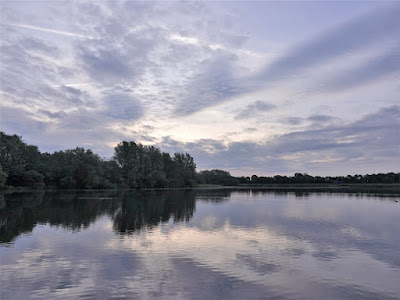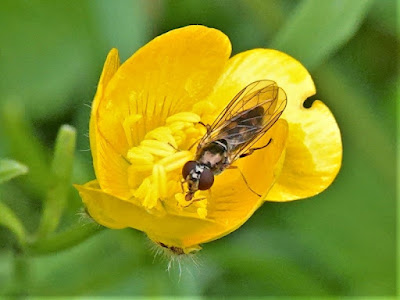12.0°C > 14.0°C: Early broken cloud soon filled in and lowered. Some light drizzle. Light westerly breeze. Very good visibility, less in drizzle.
Sunrise: 04:51 BST
* = a species photographed today
! = a new species for me here this year
!! = a new species for me in Shropshire
Priorslee Balancing Lake: 05:00 – 06:15 // 07:20 – 09:30
(118th visit of the year)
Bird notes:
- now the Canada Goose goslings and their parents have gone. I could find no sign of feathers suggesting a fight with a fox (or dog?). I am forced to conclude that the cob Mute Swan probably drowned the goslings and the parents left.
- the Common Whitethroat was again heard alarm-calling at the West end at 5:10 with a male was seen briefly.
- no Starlings noted. The youngsters likely all fully fledged and taken by their parents to feed in open country.
Counts of birds noted flying over:
- 1 Canada Goose: outbound
- 9 Wood Pigeons
- 2 Lesser Black-backed Gulls
- 3 Jackdaws
- 1 Rook
Hirundines etc. noted: see notes
- 10 Swifts
- 2 Barn Swallows
- 2 House Martins
Warblers noted (the figure in brackets relates to birds heard singing):
- 1 (1) Cetti's Warbler
- 12 (12) Chiffchaffs
- 8 (8) Reed Warblers
- 11 (14) Blackcaps
- 1 (0) Common Whitethroat
'nominal' warbler:
- 2 (2) Goldcrests
Counts from the lake area:
- no geese
- 2 + 1 (1 brood) Mute Swans
- 3 (3♂) Mallard
- 3 Moorhens
- 22 + 3 (2 broods) Coots
- 5 Great Crested Grebes
- 1 Grey Heron: early only
Noted on the street lamps poles pre-dawn:
Nothing
Noted later:
** despite the dull weather I managed to find more than I expected.
Noted later:
** despite the dull weather I managed to find more than I expected.
Moths:
- Plain Gold Micropterix calthella
- *!!possible Speckled Tip Moth Argyresthia retinella : would be new for me
- *Common Marble Celypha lacunana
- *!Epiblema sp. either Thistle Bell (Epiblema scutulana) [Thistle Root-borer] or Knapweed Bell (Epiblema cirsiana)[Knapweed Root-borer]
- *!another one to be identified
- Plain Gold Micropterix calthella
- *!!possible Speckled Tip Moth Argyresthia retinella : would be new for me
- *Common Marble Celypha lacunana
- *!Epiblema sp. either Thistle Bell (Epiblema scutulana) [Thistle Root-borer] or Knapweed Bell (Epiblema cirsiana)[Knapweed Root-borer]
- *!another one to be identified
Bees, wasps etc.:
- *Red-tailed Bumblebee Bombus lapidarius
- Common Carder Bee Bombus pascuorum
- Early Bumblebee Bombus pratorum
- Buff-tailed Bumblebee Bombus terrestris
- *Red-tailed Bumblebee Bombus lapidarius
- Common Carder Bee Bombus pascuorum
- Early Bumblebee Bombus pratorum
- Buff-tailed Bumblebee Bombus terrestris
Hoverflies:
- Buttercup Blacklet Cheilosia albitarsus [Late Buttercup Cheilosia]
- Marmalade Hoverfly Episyrphus balteatus
- *Common Dronefly Eristalis tenax
- *Migrant Field Syrph Eupeodes corollae [Migrant Hoverfly; Migrant Aphideater]
- *Chequered Hoverfly Melanostoma scalare [Long-winged Duskyface]
- Buttercup Blacklet Cheilosia albitarsus [Late Buttercup Cheilosia]
- Marmalade Hoverfly Episyrphus balteatus
- *Common Dronefly Eristalis tenax
- *Migrant Field Syrph Eupeodes corollae [Migrant Hoverfly; Migrant Aphideater]
- *Chequered Hoverfly Melanostoma scalare [Long-winged Duskyface]
Damsel-/dragon-flies:
- Common Blue Damselfly Enallagma cyathigerum
- Blue-tailed Damselfly Ischnura elegans
- Common Blue Damselfly Enallagma cyathigerum
- Blue-tailed Damselfly Ischnura elegans
Other flies:
- *Black Snipefly Chrysopilus cristatus: males
- *dance fly probably Hybos culiciformis
Scorpion Fly Panorpa sp.
- *Yellow Dung Fly Scathophaga stercoraria
- *!Blackfly Simulium sp., possibly S. angustitarse
- many other unidentified species
- *Black Snipefly Chrysopilus cristatus: males
- *dance fly probably Hybos culiciformis
Scorpion Fly Panorpa sp.
- *Yellow Dung Fly Scathophaga stercoraria
- *!Blackfly Simulium sp., possibly S. angustitarse
- many other unidentified species
Bugs etc.:
- *Black Kneed Capsid Blepharidopterus angulatus
- *Mirid bug Calocoris alpestris
- *Common Green Capsid Lygocoris pabulinus
- *presumed nymph, unidentified
- *Black Kneed Capsid Blepharidopterus angulatus
- *Mirid bug Calocoris alpestris
- *Common Green Capsid Lygocoris pabulinus
- *presumed nymph, unidentified
Beetles:
- 2 Spot Ladybird Adalia bipunctata
- Alder Leaf Beetle Agelastica alni
- Raspberry Beetle Byturus tomentosus
- False Blister Beetle: Oedemera lurida or O. virescens
- Swollen-thighed Beetle Oedemera nobilis
- *Common or Red-headed Cardinal Beetle Pyrochroa serraticornis
- 2 Spot Ladybird Adalia bipunctata
- Alder Leaf Beetle Agelastica alni
- Raspberry Beetle Byturus tomentosus
- False Blister Beetle: Oedemera lurida or O. virescens
- Swollen-thighed Beetle Oedemera nobilis
- *Common or Red-headed Cardinal Beetle Pyrochroa serraticornis
Molluscs:
- White-lipped Snail Cepaea hortensis
- White-lipped Snail Cepaea hortensis
Spiders:
- *Furrow Orbweaver Larinioides cornutus
- *money spider not Philodromus dispar
- Long-jawed Orb-web Spider Tetragnatha sp.
No new flowers but photo of:
- *Common Spotted-orchids Dactylorhiza fuchsii
- *Furrow Orbweaver Larinioides cornutus
- *money spider not Philodromus dispar
- Long-jawed Orb-web Spider Tetragnatha sp.
No new flowers but photo of:
- *Common Spotted-orchids Dactylorhiza fuchsii
Just after sunrise. This was as good as it got. All downhill thereafter.
Unconfirmed moth. I think this may be a Speckled Tip Moth Argyresthia retinella: it would be new species for me. I have sent the photo to the Shropshire Recorder for his thoughts.
Somewhat "in your face" is a Common Marble Celypha lacunana. Buried amongst grass stems the only way to photograph it was to stand well back and out the camera on full electronic zoom which never gives quite the same clarity (despite the claim in the camera's on-line handbook).
A problem moth. It is from the genus Epiblema, either Thistle Bell (Epiblema scutulana) or Knapweed Bell (Epiblema cirsiana). Examples need dissection to be certain. There are thistles and knapweed in the area which does not help. Another for the thoughts of the recorder.
Unidentified moth. I have been expecting to flush Timothy Tortrix moths Zelotherses paleana from the grass: they are normally common at this time of year. This is not one. I have again sent this photo to the Shropshire Recorder for his thoughts. For scale that is a grass seed-head it is resting on.
A Red-tailed Bumblebee Bombus lapidarius.
A Common Dronefly Eristalis tenax. They have been anything but 'common' so far this year.
A Migrant Field Syrph hoverfly Eupeodes corollae also known as a Migrant Hoverfly or Migrant Aphideater. Is resident in the UK and the numbers are only swollen by migrants (don't go there!).
A Chequered Hoverfly Melanostoma scalare. It is not clear to me why this species is also called Long-winged Duskyface.
Very common but well-posed: a Black Snipefly Chrysopilus cristatus: male.
This is a dance fly probably Hybos culiciformis.
Come on: you know you like Yellow Dung Flies Scathophaga stercoraria really!
Again.
As far as I can tell this is a Blackfly from the genus Simulium, possibly S. angustitarse. This group of insects is not related in any way to blackfly aphids. Not the rather long antennae, suggesting perhaps a bee species.
A tiny red-eyed and long-legged fly. No idea as to species.
I know everything eventually dies. I seem to have noted many things dead without any obvious predator around. A fly.
Now a dead cranefly. The bug is a Black Kneed Capsid Blepharidopterus angulatus. Being a 'plant bug' extracting the sap from plant stems for food makes it an unlikely culprit.
With no black collar this may well be a Common Green Capsid Lygocoris pabulinus. I cannot speculate about the black marks on the leaf. I doubt they are anything to do with the bug.
This Common or Red-headed Cardinal Beetle Pyrochroa serraticornis brightened up the dull morning. This shows well the "serraticornis" = serrated antennae.
Not at all sure about this. I think two bug instars have attacked a midge. Beyond that I cannot speculate.
Also a capsid bug nymph perhaps.
Today's photo for arachnophobes. It is a Furrow Orbweaver Larinioides cornutus .
An unidentified money spider and not a Philodromus dispar as Obsidentify suggested. It does not always get things correct!
A fine group of Common Spotted-orchids Dactylorhiza fuchsii. It is the leaves that are "spotted" as clearly shown here.
(Ed Wilson)
------------------------------------------------------------------------------------------------------
In the Priorslee Avenue tunnel:
Moths:
- *!Flame Carpet Xanthorhoe designata
plus the usual midges of several species
- *!Flame Carpet Xanthorhoe designata
plus the usual midges of several species
A Flame Carpet moth Xanthorhoe designata on the wall of the tunnel. Not very 'flame'-coloured. The thick, dark inner edge to the cross-line is the best clue here.
The Flash: 06:20 – 07:15
(Ed Wilson)
------------------------------------------------------------------------------------------------------
The Flash: 06:20 – 07:15
(121st visit of the year)
Bird notes:
- large build-up of Canada Geese for the post-breeding wing moult. No significant number of Greylags as yet.
- surprise was the presence of four Canada Goose goslings. These were well over a week old so where have they been. I am sure they were too small to be the goslings missing from the Balancing Lake. And in any case how did they get here? They cannot fly and it is a long, long way to walk.
- the feral Mallard-types seen again.
Bird(s) noted flying over here:
Bird notes:
- large build-up of Canada Geese for the post-breeding wing moult. No significant number of Greylags as yet.
- surprise was the presence of four Canada Goose goslings. These were well over a week old so where have they been. I am sure they were too small to be the goslings missing from the Balancing Lake. And in any case how did they get here? They cannot fly and it is a long, long way to walk.
- the feral Mallard-types seen again.
Bird(s) noted flying over here:
None
Hirundines etc. noted:
- 8 Swifts
- 2 House Martins
Warblers noted (the figure in brackets relates to birds heard singing):
- 4 (4) Chiffchaffs
- 2 (2) Blackcaps
'nominal' warbler:
- 3 (3) Goldcrests
Noted on / around the water:
- *114 + 4 (1 brood) Canada Geese
- 4 Greylag Geese
- 12 + 3 (1 brood) Mute Swans
- 17 (12♂) Mallard
- *2 (?♂) feral Mallard-type
- 5 (3♂) Tufted Duck
- 4 Moorhens
- 21+ 6 (3 broods) Coots
- 2 Great Crested Grebes
Noted elsewhere around The Flash:
Hirundines etc. noted:
- 8 Swifts
- 2 House Martins
Warblers noted (the figure in brackets relates to birds heard singing):
- 4 (4) Chiffchaffs
- 2 (2) Blackcaps
'nominal' warbler:
- 3 (3) Goldcrests
Noted on / around the water:
- *114 + 4 (1 brood) Canada Geese
- 4 Greylag Geese
- 12 + 3 (1 brood) Mute Swans
- 17 (12♂) Mallard
- *2 (?♂) feral Mallard-type
- 5 (3♂) Tufted Duck
- 4 Moorhens
- 21+ 6 (3 broods) Coots
- 2 Great Crested Grebes
Noted elsewhere around The Flash:
Bees etc.:
- Early Bumblebee Bombus pratorum
- Early Bumblebee Bombus pratorum
Flies:
- *owl midge Psychodidae sp.
- *various other unidentified midges
- *owl midge Psychodidae sp.
- *various other unidentified midges
Beetles:
- Alder Leaf Beetle Agelastica alni
- Alder Leaf Beetle Agelastica alni
Fish:
- *!I assume it was the Carp Cyprinus carpio that were spawning.
- *!I assume it was the Carp Cyprinus carpio that were spawning.
The group of four Canada Goose goslings with a parent.
Again. These seem smaller than the goslings now missing from the Balancing Lake. But where have they been hiding?
The two feral Mallard. The head markings and profile both suggest Mallard. Neither has the usual curled tail-feather of drake Mallard. Oddly the bills are all-black which might otherwise suggest drake Gadwall which they are not.
One on close-up. No further clues here. 'Feral Mallard' they remain.
An owl midge Psychodidae sp. They are fuzzy before the camera struggles with them in low light.
One of many midges of an unknown species I am seeing everywhere at the moment.
Much thrashing about in the water this morning. I assume it is the Carp Cyprinus carpio spawning.
(Ed Wilson)
------------------------------------------------------------------------------------------------------
Sightings from previous years
2009
Priorslee Lake
Oystercatcher
(Ed Wilson)
2006
Priorslee Lake
Possible Marsh Harrier
11 Reed Warblers
(Ed Wilson)
































